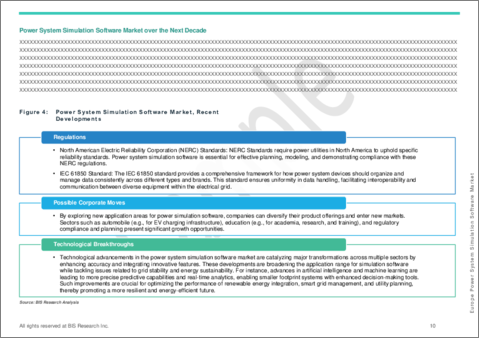|
|
市場調査レポート
商品コード
1622836
欧州の電力系統シミュレーションソフトウェア市場:用途別、製品別、国別 - 分析と予測(2023年~2033年)Europe Power System Simulation Software Market: Focus on Application, Product, and Country - Analysis and Forecast, 2023-2033 |
||||||
カスタマイズ可能
|
|||||||
| 欧州の電力系統シミュレーションソフトウェア市場:用途別、製品別、国別 - 分析と予測(2023年~2033年) |
|
出版日: 2024年12月27日
発行: BIS Research
ページ情報: 英文 72 Pages
納期: 1~5営業日
|
全表示
- 概要
- 図表
- 目次
欧州の電力系統シミュレーションソフトウェアの市場規模は、2023年の4億1,750万米ドルから2033年には9億60万米ドルに達し、予測期間の2023年~2033年のCAGRは7.05%になると予測されています。
製造業、電力、再生可能エネルギーなどの部門全体で、信頼性が高く効果的なエネルギー管理に対する需要が高まっていることが、欧州の電力系統シミュレーションソフトウェア市場を牽引しています。スマートグリッド技術や再生可能エネルギー統合が普及するにつれ、高度なシミュレーションツールは、グリッドの信頼性向上、配電の最適化、運用効率の向上に欠かせないものとなっています。企業が二酸化炭素排出量の削減と厳しい規制の遵守に取り組む中、環境意識の高まりと持続可能なエネルギー慣行の推進が需要をさらに押し上げています。政府の政策と研究開発費によって成長は加速しており、市場が持続可能性の目標と技術進歩の最前線にとどまることを保証しています。
| 主要市場統計 | |
|---|---|
| 予測期間 | 2023年~2033年 |
| 2023年評価 | 4億1,750万米ドル |
| 2033年予測 | 9億60万米ドル |
| CAGR | 7.05% |
欧州の電力系統シミュレーションソフトウェア市場は、発電、配電、再生可能エネルギー発電、産業用途など、さまざまな分野で信頼性が高く効果的なエネルギー管理ソリューションに対するニーズが高まっていることから、急速に拡大しています。よりクリーンで持続可能なエネルギー源への継続的なシフトにより、スマートグリッド技術の採用と再生可能エネルギーの現行グリッドへの組み込みが不可欠となっています。配電を最適化し、送電網の安定性を高め、運用効率を保証する高度なシミュレーションツールの必要性は、この変化に後押しされています。
エネルギー事業者は、電力系統シミュレーションソフトウェアの助けを借りて、電力ネットワークをモデル化・分析し、起こり得る障害を予測し、系統のパフォーマンスを向上させることができます。これは、断続的で分散化した電源の存在により、エネルギー事情が複雑化する中で極めて重要です。さらに、欧州全域で環境意識の高まりと厳しい規制の枠組みが、持続可能なエネルギー慣行の導入とカーボンフットプリントの削減を組織に促しており、こうしたソリューションの需要をさらに押し上げています。
政府のイニシアティブ、スマートグリッドインフラへの投資、研究開発活動の活発化により、市場の拡大が予想されます。こうした取り組みを通じて、電力系統シミュレーション・ソフトウェアは今後も進化を続け、業界が持続可能性目標を達成し、急速に変化する欧州のエネルギー情勢に適応できるよう支援します。
当レポートでは、欧州の電力系統シミュレーションソフトウェア市場について調査し、市場の概要とともに、用途別、製品別、国別の動向、および市場に参入する企業のプロファイルなどを提供しています。
目次
エグゼクティブサマリー
第1章 市場
- 動向:現在および将来の影響評価
- サプライチェーンの概要
- 研究開発レビュー
- 規制状況
- ステークホルダー分析
- 主要な世界的出来事の影響分析-COVID-19、ロシア/ウクライナ紛争、中東危機
- 市場力学:概要
第2章 地域
- 地域別概要
- 促進要因と抑制要因
- 欧州
第3章 市場-競合ベンチマーキングと企業プロファイル
- 今後の見通し
- 地理的評価
- Siemens
- DIgSILENT
- ABB
- Schneider Electric
- Plexim GmbH
- DNV GL
- その他
第4章 調査手法
List of Figures
- Figure 1: Power System Simulation Software Market (by Region), $Million, 2023, 2027, and 2033
- Figure 2: Europe Power System Simulation Software Market (by Application), $Million, 2023, 2027, and 2033
- Figure 3: Europe Power System Simulation Software Market (by Module Type), $Million, 2023, 2027, and 2033
- Figure 4: Power System Simulation Software Market, Recent Developments
- Figure 5: Supply Chain and Risks within the Supply Chain
- Figure 6: Power system simulation software market, Global Pricing Snapshot, $/Month, 2022, 2027, and 2033
- Figure 7: Patent Analysis (by Country), January 2020 and December 2023
- Figure 8: Patent Analysis (by Company), January 2020 and December 2023
- Figure 9: Germany Power System Simulation Software Market, $Million, 2022-2033
- Figure 10: U.K. Power System Simulation Software Market, $Million, 2022-2033
- Figure 11: Southern and Mediterranean Europe Power System Simulation Software Market, $Million, 2022-2033
- Figure 12: Eastern Europe Power System Simulation Software Market, $Million, 2022-2033
- Figure 13: Nordic Region Power System Simulation Software Market, $Million, 2022-2033
- Figure 14: Strategic Initiatives, 2021-2023
- Figure 15: Share of Strategic Initiatives, 2021-2023
- Figure 16: Data Triangulation
- Figure 17: Top-Down and Bottom-Up Approach
- Figure 18: Assumptions and Limitations
List of Tables
- Table 1: Market Snapshot
- Table 2: Power System Simulation Software Market, Opportunities across Regions
- Table 3: Impact Analysis of Market Navigating Factors, 2023-2033
- Table 4: Power System Simulation Software Market (by Region), $Million, 2022-2033
- Table 5: Europe Power System Simulation Software Market (by Application), $Million, 2022-2033
- Table 6: Europe Power System Simulation Software Market (by Module Type), $Million, 2022-2033
- Table 7: Germany Power System Simulation Software Market (by Application), $Million, 2022-2033
- Table 8: Germany Power System Simulation Software Market (by Module Type), $Million, 2022-2033
- Table 9: U.K. Power System Simulation Software Market (by Application), $Million, 2022-2033
- Table 10: U.K. Power System Simulation Software Market (by Module Type), $Million, 2022-2033
- Table 11: Southern and Mediterranean Europe Power System Simulation Software Market (by Application), $Million, 2022-2033
- Table 12: Southern and Mediterranean Europe Power System Simulation Software Market (by Module Type), $Million, 2022-2033
- Table 13: Eastern Europe Power System Simulation Software Market (by Application), $Million, 2022-2033
- Table 14: Eastern Europe Power System Simulation Software Market (by Module Type), $Million, 2022-2033
- Table 15: Nordic Region Power System Simulation Software Market (by Application), $Million, 2022-2033
- Table 16: Nordic Region Power System Simulation Software Market (by Module Type), $Million, 2022-2033
- Table 17: Market Share
- Table 18: Other Key players
Introduction to Europe Power System Simulation Software Market
The Europe power system simulation software market is projected to reach $900.6 million by 2033 from $417.5 million in 2023, growing at a CAGR of 7.05% during the forecast period 2023-2033. The growing demand for dependable and effective energy management across sectors like manufacturing, power, and renewable energy is driving the market for power system simulation software in Europe. Advanced simulation tools are crucial for improving grid reliability, optimizing power distribution, and increasing operational efficiency as smart grid technologies and renewable energy integration gain traction. As businesses work to lower their carbon footprints and adhere to strict regulations, growing environmental consciousness and the drive for sustainable energy practices are further fueling demand. Growth is being accelerated by government policies and R&D expenditures, guaranteeing that the market stays at the forefront of sustainability objectives and technological advancements.
Market Introduction
| KEY MARKET STATISTICS | |
|---|---|
| Forecast Period | 2023 - 2033 |
| 2023 Evaluation | $417.5 Million |
| 2033 Forecast | $900.6 Million |
| CAGR | 7.05% |
The market for power system simulation software in Europe is expanding rapidly due to the growing need for dependable and effective energy management solutions in a number of sectors, such as power generation, distribution, renewable energy, and industrial applications. The adoption of smart grid technologies and the incorporation of renewable energy into current grids have become essential due to the continuous shift towards cleaner, more sustainable energy sources. The need for sophisticated simulation tools that can optimize power distribution, enhance grid stability, and guarantee operational efficiency is being driven by this change.
Energy operators can model and analyze power networks, anticipate possible faults, and improve grid performance with the help of power system simulation software. This is crucial as the energy landscape grows more complex due to the presence of intermittent and decentralized power sources. Additionally, growing environmental awareness and stringent regulatory frameworks across Europe are pushing organizations to adopt sustainable energy practices and reduce their carbon footprints, further fueling the demand for these solutions.
It is anticipated that the market will advance due to government initiatives, investments in smart grid infrastructure, and a rise in research and development activities. Through these initiatives, power system simulation software will continue to advance, assisting industries in achieving sustainability targets and adjusting to Europe's rapidly shifting energy landscape.
Market Segmentation:
Segmentation 1: Application
- Power
- Industrial
- Others
Segmentation 2: by Module Type
- Power Flow
- Short Circuit
- Device Coordination
- Arc Flash
- Dynamic State Studies Module
- Renewable Energy Integration
- Energy Storage System Modeling
- Others
Segmentation 3: Region
- Germany
- U.K.
- Southern and Mediterranean Europe
- Eastern Europe
- Nordic Region
How can this report add value to an organization?
Product/Innovation Strategy: This report provides a comprehensive product/innovation strategy for the power system simulation software market, identifying opportunities for market entry, technology adoption, and sustainable growth. It offers actionable insights, helping organizations leverage power system simulation software to meet environmental standards, gain a competitive edge, and capitalize on the increasing demand for eco-friendly solutions in various industries.
Growth/Marketing Strategy: This report offers a comprehensive growth and marketing strategy designed specifically for the Europe power system simulation software market. It presents a targeted approach to identifying specialized market segments, establishing a competitive advantage, and implementing creative marketing initiatives aimed at optimizing market share and financial performance. By harnessing these strategic recommendations, organizations can elevate their market presence, seize emerging prospects, and efficiently propel revenue expansion.
Competitive Strategy: This report crafts a strong competitive strategy tailored to the Europe power system simulation software market. It evaluates market rivals, suggests methods to stand out, and offers guidance for maintaining a competitive edge. By adhering to these strategic directives, companies can position themselves effectively in the face of market competition, ensuring sustained prosperity and profitability.
Table of Contents
Executive Summary
Scope and Definition
1 Markets
- 1.1 Trends: Current and Future Impact Assessment
- 1.1.1 Trends: Current and Future Impact Assessment
- 1.1.1.1 Increasing Need for Grid Modernization
- 1.1.1.2 Accelerating Shift toward Renewable Energy Adoption
- 1.1.1 Trends: Current and Future Impact Assessment
- 1.2 Supply Chain Overview
- 1.2.1 Value Chain Analysis
- 1.2.2 End-User Value Chain
- 1.2.3 Pricing Forecast
- 1.3 Research and Development Review
- 1.3.1 Patent Filing Trend (by Country and Company)
- 1.3.2 Research Initiatives and Product Development Announcements (by Company)
- 1.3.2.1 Research Initiatives
- 1.3.2.2 Product Development Announcements
- 1.4 Regulatory Landscape
- 1.5 Stakeholder Analysis
- 1.5.1 Use Case
- 1.5.1.1.1 Amprion GmbH
- 1.5.1.1.2 National HVDC Centre (U.K.)
- 1.5.1.1.3 Implementing Operational Standards for Battery Energy Storage Systems
- 1.5.1.1.4 Hardware-in-the-loop Testing of Generator and Transformer Protection
- 1.5.1.1.5 Johan Sverdrup Project - Equinor
- 1.5.2 End User and Buying Criteria
- 1.5.1 Use Case
- 1.6 Impact Analysis for Key Global Events-COVID-19, Russia/Ukraine Conflict, or Middle East Crisis
- 1.7 Market Dynamics: Overview
- 1.7.1 Market Drivers
- 1.7.1.1 Rising Demand for Electricity to Propel the Expansion of the Power system simulation software market
- 1.7.1.2 Favorable Policies and Regulatory Frameworks to Drive Growth in the Market
- 1.7.1.3 Enhanced Capabilities of Simulation Software to Reduce Project Time and Cost
- 1.7.2 Market Restraints
- 1.7.2.1 High Investment and Deployment Costs
- 1.7.2.2 Concerns Surrounding Data Security
- 1.7.3 Market Opportunities
- 1.7.3.1 Rise of Smart Energy Infrastructure Worldwide
- 1.7.3.2 Renewable Energy Integration Using Simulation Software
- 1.7.1 Market Drivers
2 Regions
- 2.1 Regional Summary
- 2.2 Drivers and Restraints
- 2.3 Europe
- 2.3.1 Regional Overview
- 2.3.2 Driving Factors for Market Growth
- 2.3.3 Factors Challenging the Market
- 2.3.3.1 Application
- 2.3.3.2 Product
- 2.3.4 Germany
- 2.3.4.1 Application
- 2.3.4.2 Product
- 2.3.5 U.K.
- 2.3.5.1 Application
- 2.3.5.2 Product
- 2.3.6 Southern and Mediterranean Europe
- 2.3.6.1 Application
- 2.3.6.2 Product
- 2.3.7 Eastern Europe
- 2.3.7.1 Application
- 2.3.7.2 Product
- 2.3.8 Nordic Region
- 2.3.8.1 Application
- 2.3.8.2 Product
3 Markets - Competitive Benchmarking & Company Profiles
- 3.1 Next Frontiers
- 3.2 Geographic Assessment
- 3.2.1 Siemens
- 3.2.1.1 Overview
- 3.2.1.2 Top Products/Product Portfolio
- 3.2.1.3 Top Competitors
- 3.2.1.4 Target Customers
- 3.2.1.5 Key Personnel
- 3.2.1.6 Analyst View
- 3.2.1.7 Market Share, 2022
- 3.2.2 DIgSILENT
- 3.2.2.1 Overview
- 3.2.2.2 Top Products/Product Portfolio
- 3.2.2.3 Top Competitors
- 3.2.2.4 Target Customers
- 3.2.2.5 Key Personnel
- 3.2.2.6 Analyst View
- 3.2.2.7 Market Share, 2022
- 3.2.3 ABB
- 3.2.3.1 Overview
- 3.2.3.2 Top Products/Product Portfolio
- 3.2.3.3 Top Competitors
- 3.2.3.4 Target Customers
- 3.2.3.5 Key Personnel
- 3.2.3.6 Analyst View
- 3.2.3.7 Market Share, 2022
- 3.2.4 Schneider Electric
- 3.2.4.1 Overview
- 3.2.4.2 Top Products/Product Portfolio
- 3.2.4.3 Top Competitors
- 3.2.4.4 Target Customers
- 3.2.4.5 Key Personnel
- 3.2.4.6 Analyst View
- 3.2.4.7 Market Share, 2022
- 3.2.5 Plexim GmbH
- 3.2.5.1 Overview
- 3.2.5.2 Top Products/Product Portfolio
- 3.2.5.3 Top Competitors
- 3.2.5.4 Target Customers
- 3.2.5.5 Key Personnel
- 3.2.5.6 Analyst View
- 3.2.5.7 Market Share, 2022
- 3.2.6 DNV GL
- 3.2.6.1 Overview
- 3.2.6.2 Top Products/Product Portfolio
- 3.2.6.3 Top Competitors
- 3.2.6.4 Target Customers
- 3.2.6.5 Key Personnel
- 3.2.6.6 Analyst View
- 3.2.6.7 Market Share, 2022
- 3.2.7 Others
- 3.2.1 Siemens
4 Research Methodology
- 4.1 Data Sources
- 4.1.1 Primary Data Sources
- 4.1.2 Secondary Data Sources
- 4.1.3 Data Triangulation
- 4.2 Market Estimation and Forecast





